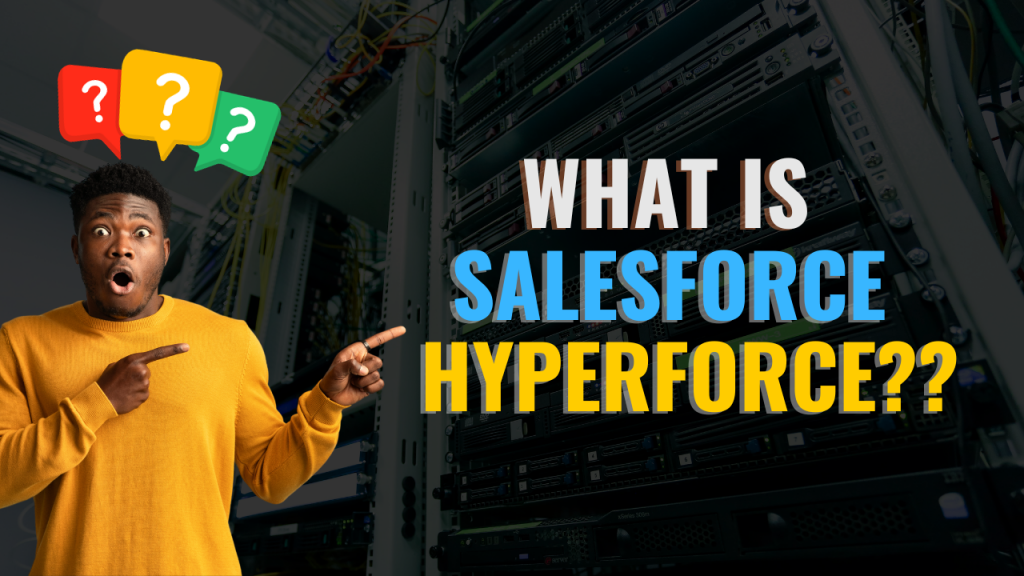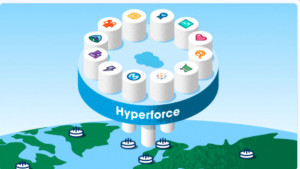What is Salesforce Hyperforce?

Introduced in 2020, Salesforce Hyperforce is a cloud-native architecture that boosts customer agility using the public cloud.
Growing with your requirements and ensuring secure, in-country data storage, its flexible infrastructure is complemented by easy maintenance for your custom apps and Salesforce integrations due to backward compatibility.
This design aims to provide customers with a more powerful and easily scalable platform. In this updated scenario, Salesforce no longer manages physical resources.
A public cloud is a computing infrastructure owned and operated by a cloud service provider like Amazon Web Services (AWS), Microsoft Azure, or Google Cloud Platform.

In the past, Salesforce hosted customers’ instances on its own infrastructure, referred to as Salesforce Infrastructure. However, with Hyperforce, organizations now have the option to run their Salesforce instances on a public cloud infrastructure of their choice.
This provides more control over the location where their data is stored and processed.
Hyperforce allows you the flexibility to select from an expanding range of global regions to host your Salesforce organization. This empowers you with increased options and control over data residency.
Salesforce Customer 360 on Hyperforce is currently available in US and Germany. To utilize the Salesforce Customer 360 application suite on Hyperforce in Switzerland and the United Arab Emirates, you must request access.
Want to Learn Salesforce Flows? Checkout our Salesforce Flow Course
Salesforce evaluates all orgs against internal Hyperforce eligibility criteria to ensure a smooth migration. Orgs that do not meet these criteria will be deferred from migration.
To qualify and be selected for Hyperforce migration, make sure your Salesforce org has enabled My Domain and that you are not utilizing HTTP 1.0 for requests to Salesforce services.
How to Find Out if Your Salesforce Org is on Salesforce Hyperforce?
Click on the gear icon and navigate to the setup menu. In the quick find box look for Company Information.
Discover your instance ID by going to Company Information, and take note of the value labelled “Instance” as displayed below.

Visit the web address https://availability.salesforce.com/find-my-instance/ input your instance name, and then select it from the dropdown menu.
As you can see in the above snapshot, for our Salesforce org the Instance ID is AP16.

Salesforce commonly hosts instances outside of Hyperforce in data centres owned and operated by the company or on cloud services compliant with government standards.
You can also click on the Instance Information button and learn more about your Salesforce org.

Benefits of Hyperforce
- You will always have the infrastructure needed to scale your business quickly and sustainably.
- Data will be as secured as it was before moving to Hyperforce.
- Storing data locally is now an option, ensuring compliance with local data laws and regulations.
- You control the privacy of your data and your customer’s data.
Also Read – How to Install Salesforce CPQ Package
FAQs
1. Are there any fees associated with using Hyperforce?
Using Hyperforce in Salesforce or migrating to Hyperforce incurs no additional fees.
2. How can I determine whether my Salesforce instance has moved to Hyperforce?
Get your instance ID from Company information in your Salesforce org and pass it to the following URL https://availability.salesforce.com/find-my-instance/
3. How to migrate to Hyperforce?
Utilize the Hyperforce Assistant for a seamless migration to Hyperforce, now available for both Salesforce production and sandbox orgs. Access it by navigating to Setup, entering “Hyperforce Assistant” in the Quick Find Box, and selecting Hyperforce Assistant.
The Prepare page leads you to the Salesforce Optimizer tool, and it provides recommendations for using mTLS or 2-way SSL with IP domains in the updated IP allowlist section.
Conclusion
In conclusion, Hyperforce is a new Salesforce architecture that provides customers with increased flexibility, scalability, and resilience. It simultaneously enhances the platform’s performance and security.
It is important to note that Hyperforce doesn’t replace the current Salesforce infrastructure but offers an additional choice to operate Salesforce instances in the public cloud. Organizations can select the option that aligns best with their specific needs and requirements.


[…] “What is Salesforce Hyperforce?” (Salesforce Geek): A detailed explanation of Salesforce Hyperforce, a reimagined architecture designed to deliver enhanced performance, scalability, and data residency options by leveraging the public cloud. […]
[…] Read more – What is Salesforce Hyperforce? […]